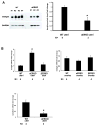Expression of basigin in reproductive tissues of estrogen receptor-{alpha} or -{beta} null mice
- PMID: 20388736
- PMCID: PMC4778977
- DOI: 10.1530/REP-10-0069
Expression of basigin in reproductive tissues of estrogen receptor-{alpha} or -{beta} null mice
Abstract
Basigin plays important roles in both male and female reproduction because basigin (Bsg) null male and female mice are infertile. The aim of the present study was to determine whether basigin expression in reproductive organs requires estrogen receptor-alpha (ESR1, ERalpha) or -beta (ESR2, ERbeta). Expression of basigin protein in the testis, ovary, and male and female reproductive tracts was studied in adult wild-type (WT), Esr1-null (alphaERKO), and Esr2-null (betaERKO) mice by immunohistochemistry and immunoblotting. Basigin mRNA levels in ovary and uterus were examined by quantitative RT-PCR. In females, basigin protein expression was observed mainly in granulosa and interstitial cells of the ovary and epithelial cells of the proximal oviduct in all genotypes. Basigin protein was also expressed in the uterine epithelium at proestrus and estrus in WT and betaERKO mice but not in alphaERKO mice. However, a higher level of basigin mRNA was observed in uteri of alphaERKO mice compared with WT and betaERKO mice. In males, basigin was expressed in Leydig cells and all germ cells except spermatogonia in all genotypes. Basigin was present in epithelial cells lining the efferent ductules in WT and betaERKO mice, but expression was greatly reduced in alphaERKO mice. In epididymal ducts, basigin expression was observed in epithelial cells in the caput and cauda in all genotypes. These data suggest that expression of basigin protein requires ESR1, but not ESR2, in the uterus and efferent ductules, but is independent of estrogen receptor in the ovary, oviduct, testis, and epididymis.
Figures








Similar articles
-
Estrogen hormone physiology: reproductive findings from estrogen receptor mutant mice.Reprod Biol. 2014 Mar;14(1):3-8. doi: 10.1016/j.repbio.2013.12.002. Epub 2013 Dec 21. Reprod Biol. 2014. PMID: 24607249 Free PMC article. Review.
-
Expression of aquaporins in the efferent ductules, sperm counts, and sperm motility in estrogen receptor-alpha deficient mice fed lab chow versus casein.Mol Reprod Dev. 2006 Feb;73(2):226-37. doi: 10.1002/mrd.20390. Mol Reprod Dev. 2006. PMID: 16261609 Free PMC article.
-
Localization of oestrogen receptor alpha, oestrogen receptor beta and androgen receptors in the rat reproductive organs.J Endocrinol. 2000 May;165(2):359-70. doi: 10.1677/joe.0.1650359. J Endocrinol. 2000. PMID: 10810300
-
Estrogen receptor-α mediates diethylstilbestrol-induced feminization of the seminal vesicle in male mice.Environ Health Perspect. 2012 Apr;120(4):560-5. doi: 10.1289/ehp.1103678. Epub 2012 Jan 24. Environ Health Perspect. 2012. PMID: 22275727 Free PMC article.
-
Estrogen receptor-alpha mediates the detrimental effects of neonatal diethylstilbestrol (DES) exposure in the murine reproductive tract.Toxicology. 2004 Dec 1;205(1-2):55-63. doi: 10.1016/j.tox.2004.06.046. Toxicology. 2004. PMID: 15458790 Review.
Cited by
-
Intercellular adhesion molecules (ICAMs) and spermatogenesis.Hum Reprod Update. 2013 Mar-Apr;19(2):167-86. doi: 10.1093/humupd/dms049. Epub 2013 Jan 3. Hum Reprod Update. 2013. PMID: 23287428 Free PMC article. Review.
-
How, with whom and when: an overview of CD147-mediated regulatory networks influencing matrix metalloproteinase activity.Biosci Rep. 2015 Nov 24;36(1):e00283. doi: 10.1042/BSR20150256. Biosci Rep. 2015. PMID: 26604323 Free PMC article. Review.
-
The Impact of Previous Exposure to COVID-19 on the Outcome of ICSI Cycles.JBRA Assist Reprod. 2023 Sep 12;27(3):367-372. doi: 10.5935/1518-0557.20220063. JBRA Assist Reprod. 2023. PMID: 37134010 Free PMC article.
-
Potential Impact of COVID-19 on Female Reproductive Health.JBRA Assist Reprod. 2023 Mar 30;27(1):92-96. doi: 10.5935/1518-0557.20220019. JBRA Assist Reprod. 2023. PMID: 35916463 Free PMC article. Review.
-
Post-COVID-19 menstrual abnormalities and infertility: Repercussions of the pandemic.J Educ Health Promot. 2022 Jun 11;11:170. doi: 10.4103/jehp.jehp_1200_21. eCollection 2022. J Educ Health Promot. 2022. PMID: 35847136 Free PMC article. Review.
References
-
- Ambros V. The functions of animal microRNAs. Nature. 2004;431:350–355. - PubMed
-
- Biswas C. Collagenase stimulation in cocultures of human fibroblasts and human tumor cells. Cancer Lett. 1984;24:201–207. - PubMed
-
- Biswas C, Zhang Y, DeCastro R, Guo H, Nakamura T, Kataoka H, Nabeshima K. The human tumor cell-derived collagenase stimulatory factor (renamed EMMPRIN) is a member of the immunoglobulin superfamily. Cancer Res. 1995;55:434–439. - PubMed
-
- Chang H, Ni H, Ma XH, Xu LB, Kadomatsu K, Muramatsu T, Yang ZM. Basigin expression and regulation in mouse ovary during the sexual maturation and development of corpus luteum. Mol Reprod Dev. 2004;68:135–141. - PubMed
Publication types
MeSH terms
Substances
Grants and funding
LinkOut - more resources
Full Text Sources
Molecular Biology Databases
Miscellaneous

